Marine kamikaze drones and the Black Sea Fleet of the Russian Navy. American expert's view
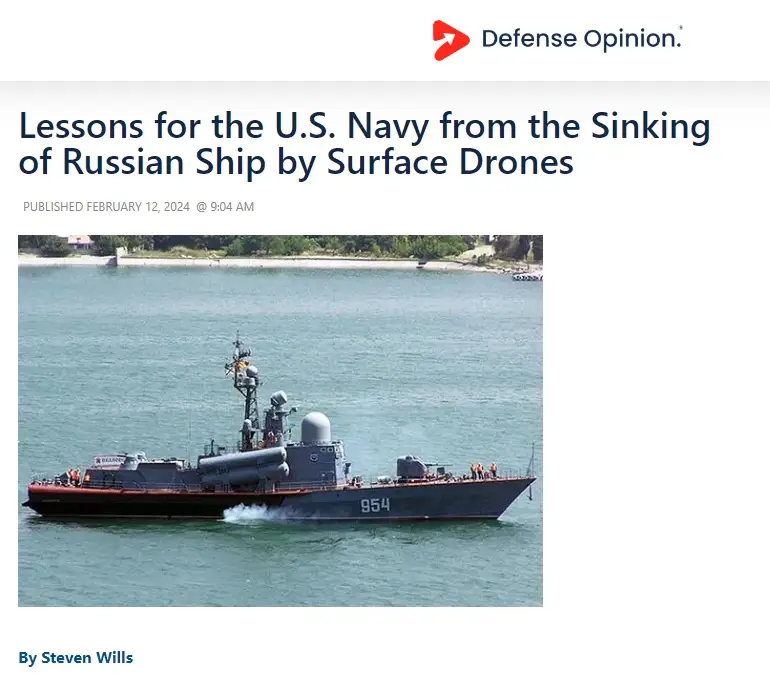
Five ways
In February 2024, defenseopinion.com published an article by Dr. historical sciences and former US Navy officer Stephen Wills, who made his analysis of the situation with counteraction to the ships of the Black Sea fleet surface drones.
The article appeared after the publication by the Main Directorate of the Ministry of Defense of Ukraine of a video of a successful drone attack on the R-31 “Ivanovets” boat (Project 2024 missile boat) on January 334, 12411. After the publication of this article, several more videos were published that captured episodes of attacks that occurred in February and March 2024 on two other ships of the Black Sea Fleet: Caesar Kunikov (BDK-64) - a large landing ship of Project 775 (775 /II); and “Sergey Kotov” - a patrol ship (corvette) of project 22160.

The author of the original material is Steven Wills. Doctor of Philosophy (military history) from Ohio University, employee of the public organization – Center for Maritime Strategy. Wills has 20 years of active service in the US Navy, and in addition to service on various ships, service in the Allied Allied Command Naples.
Both attacks were successful for the Ukrainian side, the ships were lost. At the same time, the videos show events both from the defenders and attackers, and from random witnesses to the events.
Wills suggests five relatively simple ways to reduce the threat posed by drones. It is worth noting several features of his proposals:
– he makes them in relation to the US Navy and the measures he voiced are proposed for implementation specifically by the US Navy;
- he proposes measures that are simple and applicable “here and now” (without changing the designs of ships or retrofitting them with new, not even existing, weapon systems, such as “miniguns like Iran”).
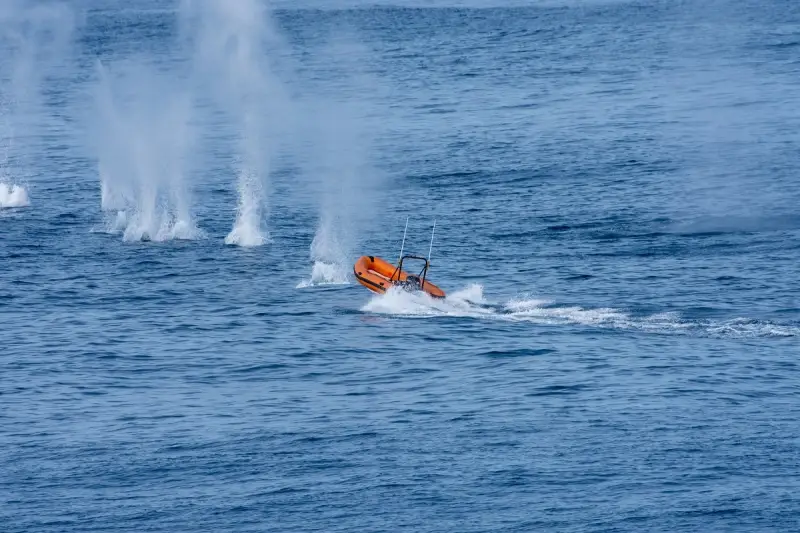
French military training to repel a naval drone attack on a surface ship, Brest, summer 2023. Sailors and special forces soldiers fire from small arms weapons for a training purpose from the frigate Bretagne (D655) of the French Navy. Even a bright motor boat, clearly visible during the day, was not sunk right away.
The measures proposed by the former US Navy officer are quite simple and, one might say, obvious. At the same time, having now in hand material from a foreign site and already published videos of two attacks that occurred after the publication of the material, we can try to do some analysis and see whether the command of the Black Sea Fleet has taken any measures to strengthen the protection of ships from surface drones.
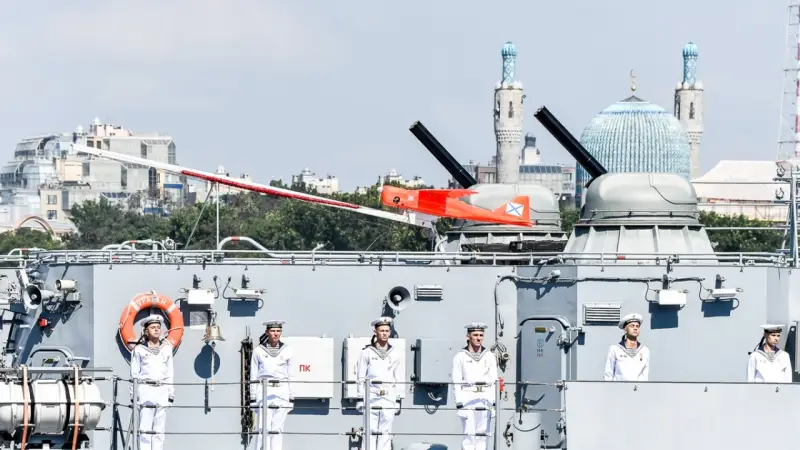
Orlan-10 on board the small rocket ship "Uragan" (project 22800) at the parade in St. Petersburg. So far, UAVs on our ships are not as common as we would like.
What measures does Wills propose in his material, and what can we say, based on the information we have now, regarding their application during the events of February and March 2024?
Were the measures proposed by the former American naval officer and, in his opinion, simple and effective, taken by the command of the Black Sea Fleet in relation to those ships that have died recently?
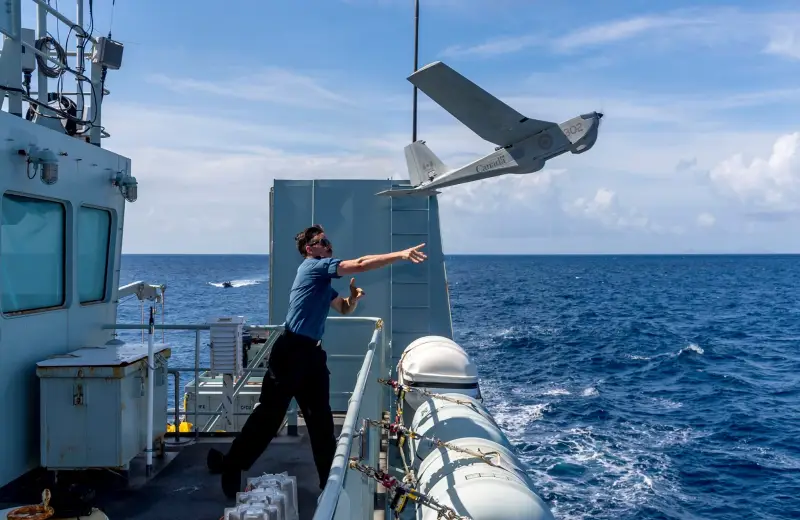
A Puma drone is launched from a Canadian Navy vessel during a joint operation with US Coast Guard ships in the Caribbean, 2021. NATO fleets first encountered enemy use of naval drones in the early 2020s during operations in the Gulf of Aden against the Houthis.
First
The first proposal is that a meeting with surface drones can happen where you absolutely do not expect it, so the level of readiness of the ship’s crew must be constantly high (in fact, constant combat readiness).
Both ships, which sank in February and March 2024, were not easy prey for naval drones. They tried to escape their pursuers and entered into battle with the drones. Most likely, the command of both the fleet and formations, and individual ships, is fully aware of the level of threats posed by the “mosquito fleet”, controlled remotely, and the degree of readiness, at least of the ship’s crews, corresponds to the threat.
The same “Sergey Kotov” repelled attacks from naval drones several times, each time more and more massive, and only the third was successful for the opposing side. In fact, the successful counteraction to naval drones in the daytime predetermined a radical change in tactics by the enemy and a transition to the massive night use of unmanned vessels.
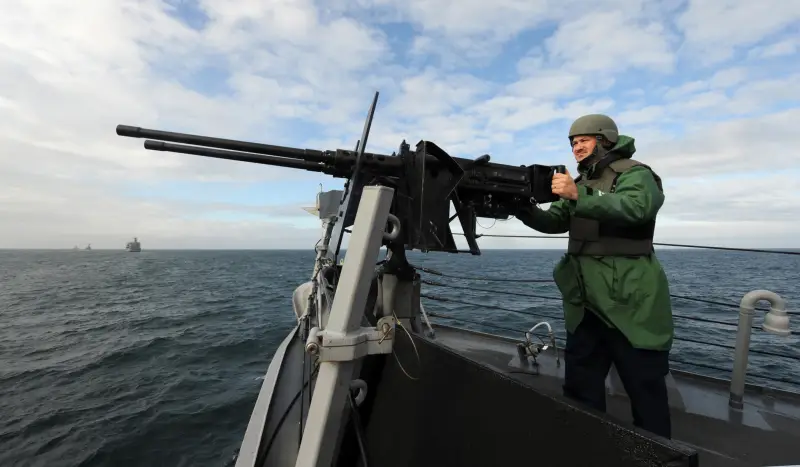
In the navies of NATO countries, large-caliber machine guns of the Browning system are truly massive weapons. The system is quite compact, and its single-barrel version can be installed as an additional firing position on many ships of the navies of NATO countries, and at least the US Armed Forces certainly have a supply of these machine guns.
But there are other systems, such as, for example, the naval version of the Bushmaster - Mk38.
Second
The second proposal that is voiced in the material is the need to use aviation and various UAVs, including small ones, for early detection of attacking surface drones.
The situation here, unfortunately, is most likely not very good.
The formation of UAV units in the Russian Navy began back in 2013. The first two UAV detachments were created in Severomorsk and Kamchatka. The first mass-produced UAV on our ships was a variant of the land-based Orlan-10. But not all ships have aircraft-type UAVs. In January 2024, the Russian Ministry of Defense announced that it was just going to equip all large landing craft with standard UAVs. Project 22160 corvettes, at least in theory, should carry up to four Orlan-10 UAVs.
Small UAVs, which have become a truly widespread phenomenon at the front, are not found on ships as a class. The fact is that in the infantry, small drones are often a massive and frequent, but private initiative from below, that is, they are bought by the fighters themselves, by the command of specific units, or delivered by volunteers/“humanitarian workers.”
And now the flow of Maviks going to the North Military District zone through volunteers definitely bypasses the fleet. And it’s unlikely that most of these drones will be useful now that the enemy has switched to almost entirely nighttime use of surface kamikaze drones.
True, land-based UAVs can also help here. Incidents of maritime unmanned kamikaze attacks occur quite close to the coast. This is a feature of the unmanned ships used by our enemy - their seaworthiness and autonomy actually leave much to be desired. And what can you expect from equipment actually assembled around a Chinese commercial jet ski?
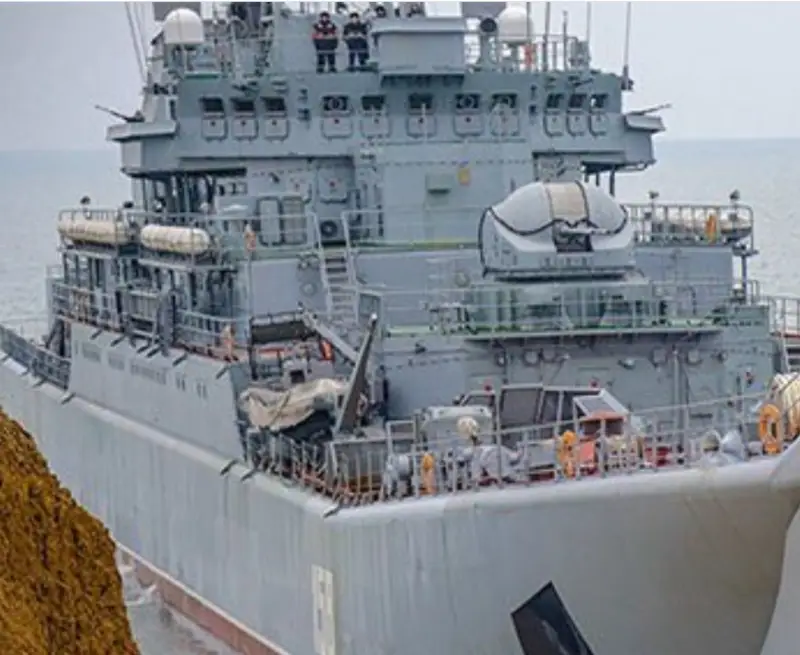
Photo of one of the training landings from the Caesar Kunikov landing ship. Two Kord machine guns are clearly visible. In the footage of the ship's defense from kamikaze drones, these machine guns are neither seen nor heard.
With airplanes everything is more complicated.
There was enough material about the problems of our Air Force in general and certain types of aircraft in particular, including on our website. There is no point in repeating ourselves. In naval aviation everything is generally the same.
The third
The third proposal is the need to maintain constant combat readiness of all ship systems.
Wills talks about the unavailability of all ship systems using the example of the Ivanovets boat, based on a video of the attack, which shows that the fire of the 30-mm AK-630 gun was completely ineffective. However, in this case, this is a feature of this system, which is simply not intended and, accordingly, not adapted (or rather, its guidance and fire control systems) for firing at such targets almost point-blank.
This system showed its low effectiveness against small targets at short distances even during the period when our warships were in the Gulf of Aden, where they protected shipping from Somali pirates. However, we all saw in the example of the cruiser “Moskva” what the presence of inoperative systems on a ship leads to...
It is difficult to say anything definite about this in recent cases; one can only assume that on the completely new Project 22160 corvette, all systems were in good working order and working properly. At least, I really want to believe it.
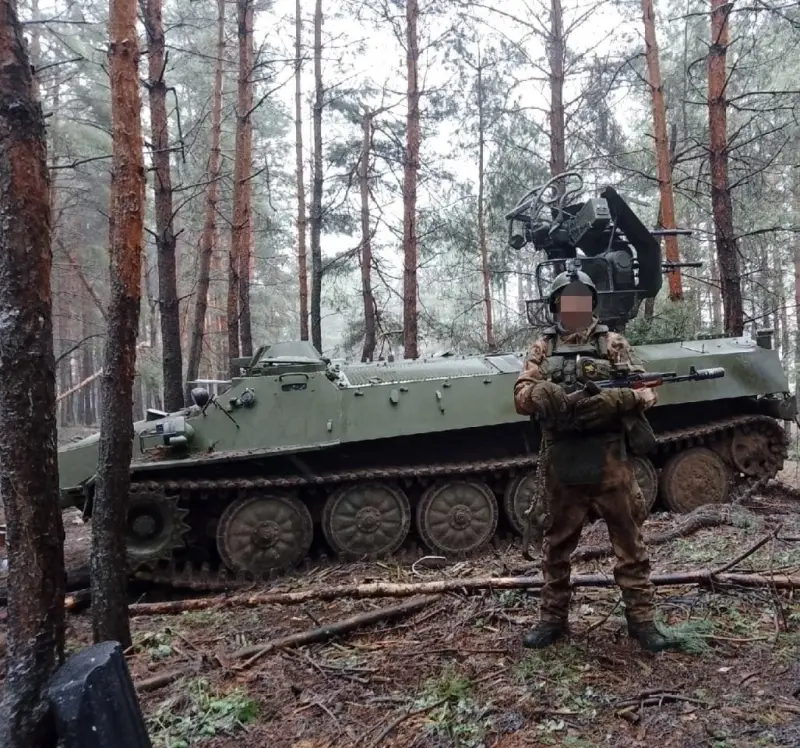
MT-LB of the Russian Armed Forces with a 2M-7 naval installation installed on it in the area of the Northern Military District, 2023. At one time, sending these systems to the front seemed like a good idea, now, perhaps, one can argue: where are they actually more needed - at the front or on ships?
Fourth
The fourth point is that it is necessary to increase the number of weapon systems serviced by the crew, located on the decks and superstructures of the ship for defense against surface drones.
The conclusion was made on the basis that the last (for the author of the original material) attack took place at a minimum distance; the main calibers of the Ivanovets boat in this case turned out to be essentially useless. Subsequent events only confirmed that the expert was right; in February and March, our sailors also had to fight off boats that had already come close to the ships.
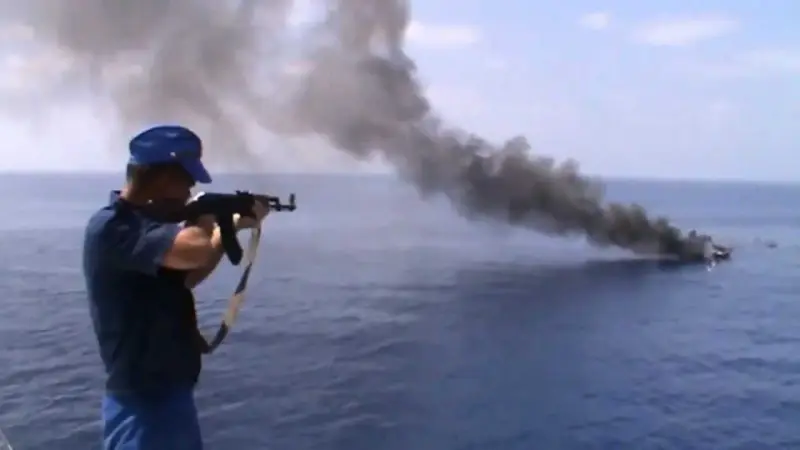
A still from a video filmed on board the Marshal Shaposhnikov ship, sailors shooting at the “floating mothership” of Somali pirates from various small arms and an RPG-7 grenade launcher. The video clearly shows that machine gun fire is absolutely useless, and the ship is finished off by a shot from an RPG-7. True, the pirate ship in this case is larger than kamikaze drones.
First of all, the expert talks about fiftieth-caliber gun systems, and more precisely, about Browning system machine guns, which are very widespread not only in the US Navy, but also in all navies of NATO countries. He himself writes that, although these systems are widespread, they will probably not be as effective against sea drones as against small ships with crews (pirate boats in the same Gulf of Aden), but still additional such systems will definitely prove useful, especially when repelling attacks already at minimal distances.
And here, unfortunately, the situation is most likely very difficult. It’s not that there are no machine guns, but there are not enough of them, and there is a serious lack of them, and we are not talking about the fleet, but about the armed forces as such.
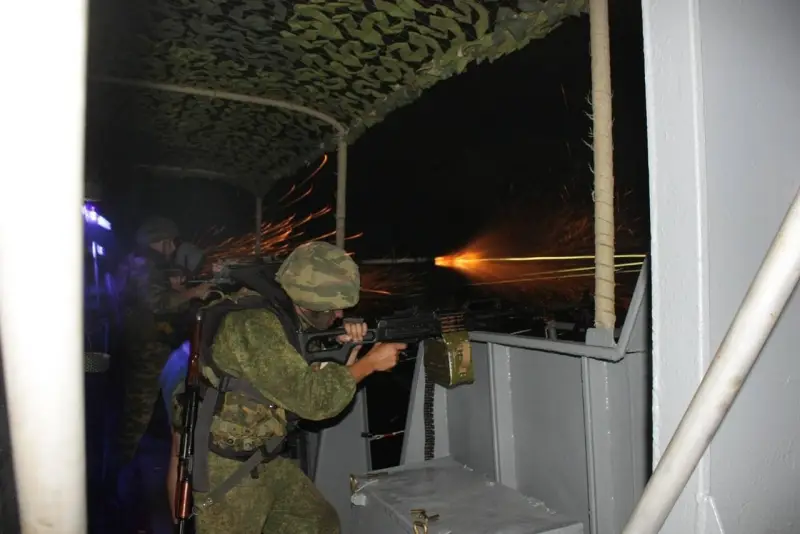
Footage of the battle between our Marines and Somali pirates. The Kord and PKM tandem could most likely be more effective against naval drones than the PKM and AK tandem.
In fact, one of the recently published videos shows us attempts to defend the BDK by the crew. Not only do we not see or hear the Kord machine guns in the footage, which should normally be placed one on each side of the wheelhouse, we clearly see that the bulk of the fighters are firing at the drones from 5,45 mm machine guns.
A fighter with a Kalashnikov machine gun of 7,62x54 caliber does not have an equipped position for firing. At some point, we see how he, tired of holding a machine gun in his hands, simply places it on the bulwark and fires virtually from the hip.
In addition, we see that at least one drone, being damaged, begins to describe a circulation. At the same time, we do not see the detonation of the charges of the drones themselves, from which we can conclude that, most likely, the fire of rifle-caliber machine guns in this case was not very effective, and machine gun fire was completely ineffective. Also, the defenders do not have any specialized sighting devices or surveillance equipment.
And the available footage from the opposing side clearly shows that the drones themselves are controlled using television cameras.
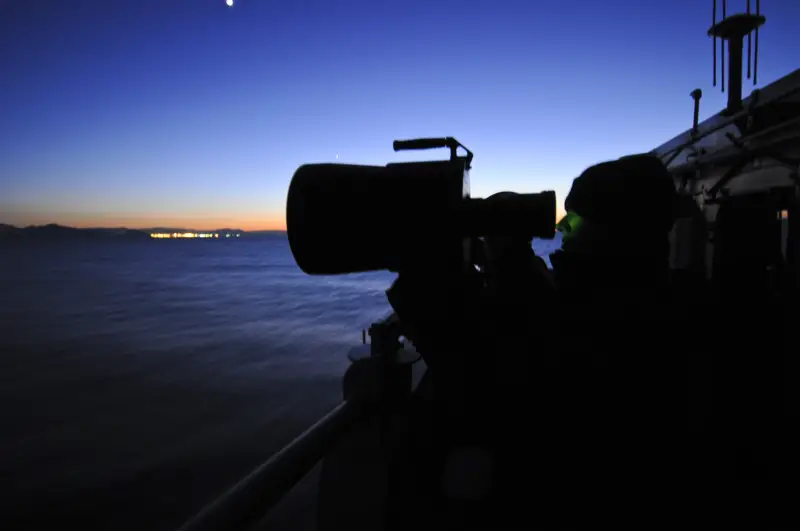
Visual observation posts, including night ones, are standard practice in the navies of NATO countries. Now they have simply been supplemented with various technical surveillance equipment to reduce the load on the crew. An American sailor with night binoculars aboard the cruiser USS Anzio (CG 68) on duty while passing Gibraltar, November 2011.
But let's get back to machine guns.
The situation with them at present is difficult, to say the least – difficult. Recently, there has been a tendency to send 14,5 mm naval machine gun mounts from the fleet to active units on the land front. It is clear that the KPVT machine gun, with its rate of fire and barrel life, is not capable of creating a fire density that would allow it to effectively combat small-sized maneuvering naval drones, especially at night.
But such systems would definitely not be superfluous and would be an excellent addition to 12,7 mm machine guns, especially since a hit from 14,5 mm ammunition would be guaranteed to send a Chinese jet ski lined with fiberglass to the bottom. But we don’t even seem to see regular “Kordas” in the footage of defense against drones... Perhaps they are already at the front, like naval installations with KPVT.
The situation with machine guns, although not as tense as that of our opponents, is still difficult. There are no DP-27s and Maxims of the 1910/1930 model in combat units yet, and all the screams and sighs about the fact that they are already fighting on our side are still based only on a few photographs of our soldiers with captured Ukrainian systems and the desire of some commentators “ride the hype.”
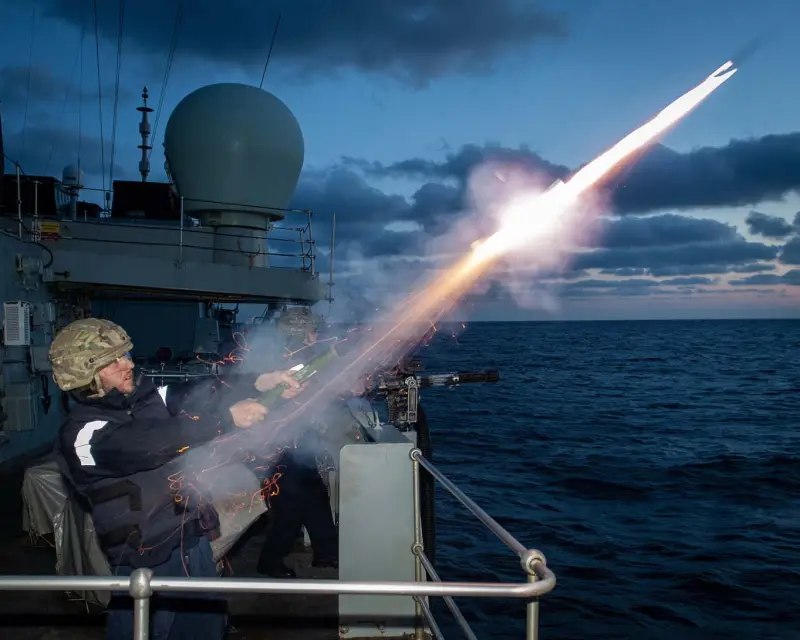
Our sailors are already engaged in fire combat, they have already been discovered by the enemy, who sees perfectly in the dark... But they themselves are blind, since they do not have specialized observation equipment and sights, and several searchlights are clearly not enough. Well, why not use old, proven, and most importantly, cheap tools? British sailors fire a flare from the frigate HMS St Albans (F83) during night firing training, 2021. In the background you can see another effective tool for combating small maneuvering targets - a minigun.
However, Degtyarev’s light machine guns are definitely appearing at the front.
The irony is that at one time this machine gun appeared as a response to the acute shortage of light machine guns in the Red Army. In fact, this was a temporary measure; the system began to fade into the background, and subsequently into warehouses and for export with the advent and establishment of mass production of the Kalashnikov system machine gun.
And here again there is a lack of machine guns, and again the RPD comes onto the scene. The situation with machine gun armament is most likely not expected to normalize in the near future. And not with rifle-caliber machine guns, nor with 12,7 mm machine guns.
The country's only current manufacturer of Kalashnikov machine guns and Kord machine guns does not have any ability to increase production volumes.
And in general, the situation with the Degtyarev Plant is quite complicated, which is worth at least the fact that 49,88% of the shares of the joint stock company belong to Globalvoentrading Ltd. LLC, which in turn, through several “layers”, is 100% owned by the Cyprus Megapolis Holdings (Overseas) Limited." It is clear that this is, in general, a formality, an attempt by real shareholders to simultaneously avoid a raider takeover and secure their profits (hello from the 90s), but still the situation is indicative.
Fifth
And finally, point five is the need to set up additional posts and organize the simplest primitive visual observation.
Additional optical or radar detection equipment may not be able to be installed on the ship, and additional personnel to provide and maintain them may simply not be located anywhere. And these funds themselves may not be available. And posting additional posts is most likely not problematic.
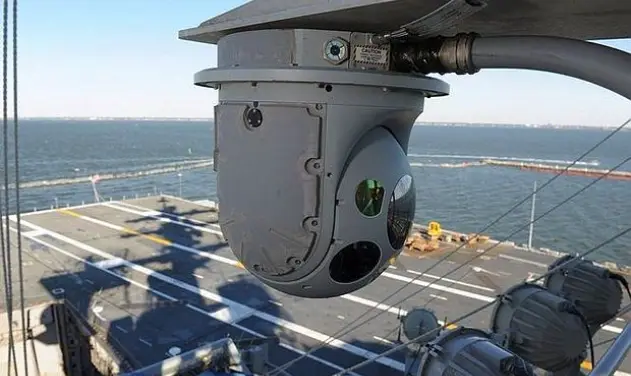
FLIR Star Safire III optical system on the superstructure of the aircraft carrier USS Dwight D. Eisenhower (CVN 69). This, so to speak, “camera” is a real all-weather optical reconnaissance system that is installed on both ships and aircraft. This is one of the modern means of surveillance and reconnaissance, which is designed, among other things, to combat the threat of unmanned attack vehicles. What the radar does not see can be seen by a high-resolution camera with IR illumination, the images from which are analyzed by AI and the operator, what they do not see can be seen by a sailor with binoculars on the deck.
Considering that the latest videos that we could study show us that drones were detected, and ships were trying to escape from the attack, and fire was fired at the attackers, perhaps including the simplest and most obvious system of visual observation posts, the organization of 24-hour guards allows our sailors to have some chance of early detection, and the opportunity to take arms in their hands to protect their ship from a new surface threat.
Most likely, some of the measures that the expert describes and proposes were taken by the fleet. For now, most likely, the weak point is precisely the early detection of drones in the dark, as well as the organization and conduct of defensive fire against attacking drones at minimum distances. There is a clear lack of specialized surveillance capabilities, given that all recent attacks have been carried out at night. Obviously, there are not enough weapon systems, both machine guns and grenade launchers.
At the same time, it must be said that our fleet has experience in organizing counteraction on large surface vessels to attacks by small-sized maneuvering targets. And not in such a distant past. Fleet ships participated in ensuring navigation and fighting Somali pirates in the Horn of Africa. Information has repeatedly appeared in the Internet media and in television reports that sailors not only freed ships captured by pirates, but also repelled attacks on their own ships.
The measures taken by the command of the Black Sea Fleet of the Russian Navy are clearly insufficient, ships continue to die. Perhaps it is worth listening to the opinion of a foreign expert and remembering your recent and quite successful experience.
Information